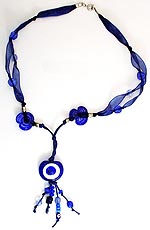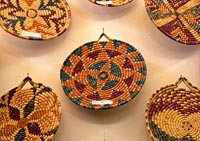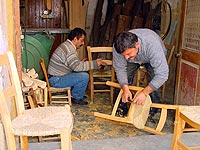
Handicrafts from Turkish Cypriot people of Northern Cyprus.
 |
the north cyprus travel guide |
 |
|
Handicrafts of North Cyprus
Evil Eye Blue Beads (Nazar Boncugu)The famous talisman of the evil eye blue bead, or nazar boncugu, is everywhere in North Cyprus, and wards off the power of the "evil eye". All around the Mediterranean, people trust the simple beads to keep them safe from the malicious looks of their neighbours, and North Cyprus is just the place to buy one of your own After all, you never know... Lefkara lace workLefkara lace used to be part of every Turkish Cypriot’s life, because the distinctive white embroidery on white cloth was always included in a bride’s trousseau. It was the Venetians who started the trend, as during their occupation of Cyprus (1489-1571) the ruling classes would go and holiday in the village of Lefkara. The local women copied the fine embroidery of the Venetian’s clothes, and adapted their own designs based on what they saw.
North Cyprus wicker baskets
You can’t help but notice the flat wicket baskets of North Cyprus; their bright and cheerful designs simply leap out at you from shops and restaurant walls all over the country. The flat baskets truly are a unique work of art, as each weaver (or knitter, as they are sometimes known) has their own distinctive weaving pattern. These flat trays, along with delicate bread baskets and jewellery caskets with lids, are made from a special type of straw. Larger baskets are made from bamboo, so they are not incredibly tough but very light as well. Yemeni, the traditional North Cyprus headscarfMany older Turkish Cypriot women wear this traditional headscarf, and with good reason, as you’ll know if you dare to venture into the Cyprus summer sun without a hat on! Originally the scarves were a sign of wealth, and the fine cotton cloth would be woven at home from thin cotton thread. The scarf was then decorated with intricate designs of leaves, branches and flowers, and worn tied around the head. Reed seated chairs from North Cyprus
You may wonder why so many craft shops in North Cyprus sell miniature chairs, each with intricately woven seats. This is a tribute to the art of reed weaving, where wooden chairs are given seats created from woven reeds. This kind of seating is extremely light yet durable, and reed seated chairs are still much in demand amongst Turkish Cypriot families. Lapithos Cross-stitch Embriodery, or Hesap, from Northern CyprusThis elegant and colourful embroidery from the Lapithos region of North Cyprus is as sunny and bright as a North Cyprus welcome! The ladies who keep this ancient tradition alive embroider onto linen cloth in which you can actually count the individual threads. The cloth is held on a ‘kasnak’ or circular wooden frame, to keep the material taut, and the outline of the design added in brown or black French silk thread. It is this outlining in thread that makes this embroidery unique; other traditions use a pencil drawn outline instead. Then, the colours are filled in using cross-stitch, to create traditional Cypriot designs. Silk weaving and silk cocoon decoration in North CyprusUp until recently, the landscape around the villages of Karava and Lapithos in North Cyprus was dotted with mulberry trees, food for hungry silk worms. Lapta and Hisarkoy were the most important villages for silk production. Every Turkish Cypriot household would take part in taking the precious silk worm cocoons, spinning out the thread and then weaving fine silk cloth. Unfortunately, the silk cloth trade in North Cyprus died out due to foreign competition, but one fascinating craft remains, North Cyprus silk cocoon decoration. Intricate silk pictures from North CyprusThanks to a government initiative, Turkish Cypriots have flocked to classes teaching this traditional craft in North Cyprus. The white silk cocoons, about the size of a plum, now come from the Karpas peninsula. Silk cocoons are quite firm to the touch, enabling each cocoon to be cut open and folded out flat, like a piece of card. Intricate shapes are then cut from this flattened cocoon and sewn onto velvet, sometimes held in place with tiny beads. North Cyprus date leaf weaving: a dying artIf you are lucky enough to find some date leaf woven products in North Cyprus, make sure you support their creator! Originally, Northern Cyprus date leaves were used to produce fans and sacks, although lightweight yet strong shopping baskets were also produced, ideal for carrying home the vegetables, and far more ecologically friendly than a plastic bag! The date leaves are cut and stored for fifteen days, before being separated from the branch. Individual leaves which are not flexible enough are soaked in water to make them more pliable, and then each leaf is split into two, retaining the ends. One leaf is placed inside another, and the two are woven with other leaves to form a length of tough, date leaf ‘rope”. This is sewed into a distinctive Northern Cyprus shopping basket using a ‘cuvaldiz’ or large packing needle, with thread made from strips of date leaf. North Cyprus kilim rugsThe Karpas peninsula may be rugged, but the hand-woven kilim rugs and carpets produced here are works of art. Their bold, striking patterns are also tough and extremely practical. More ornate embroidered rugs ‘called ‘cicim’ are also produced, as are rugs woven from Angora goat hair. Sheepskin rugs are also available. The best places to see North Cyprus handicraftsTo see the best examples, visit the Folk Arts Institute, shops in the Buyuk Han and the Handicrafts Centres in North Nicosia. Also, look for the El Sanatlari Kooperatifi sign, showing the items come from the Handicrafts Cooperative, and is authentic North Cyprus work. A show of Northern Cyprus crafts is held every year in May, near the Ataturk Stadium. |
|
North Cyprus quick: holidays | flights | hotels | property | kyrenia | famagusta | photos | map | weather | history | news
All text is copyrighted by Cyprus44. Photographs are copyrighted by their respective photographers.
For more information read our copyright policy, privacy policy and disclaimer.
This web page is served on 13 September 2025 at 5:41:02 AM.
![]()
Cyprus44 in other languages: Nordzypern | Chypre Nord | Severní Kypr | Северный Кипр
partner sites: goNorthCyprus Travel | Pacific Rent-A-Car | Amy Holiday Villas | other partner sites









